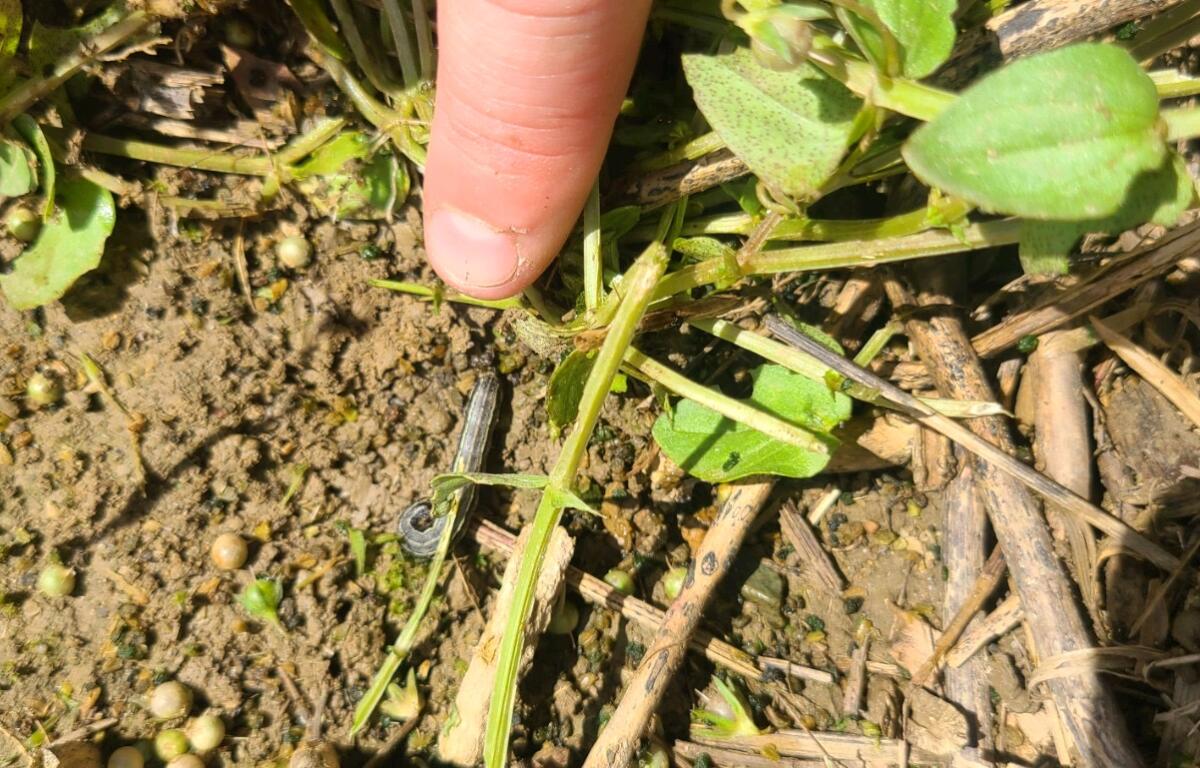
BUCYRUS – An army of worms is marching through Crawford County, wreaking havoc in its path.
Armyworms – the larvae of a moth that primarily eat grass but also eat some vegetables – are invading lawns and fields throughout North Central Ohio, turning patches of green grass brown and destroying precious crops of beans and alfalfa.
“If they’re in a farm field, they can ruin a crop. In a matter of a day, they can take the outer leaf down to the stem,” said Mike Hall, district program administrator for the Crawford Soil & Water Conservation District. “It’s amazing how fast they move, especially for a worm.”

The caterpillars, which can be from one-and-a-half to two inches long, are light green or tan early on, then turn dark green or brown when fully grown. They can also be identified by a series of green, yellow, or brown stripes down the length of their bodies.
The pests have already infested 60 acres of double-crop beans and 20 acres of alfalfa at Rus-Men Farms in Galion, according to Mendy Sellman, who runs the family farm with her husband, Russ. “They’re pretty unique looking, and literally they’re everywhere,” she said.
Sellman said the creatures have also chewed their way through a 20-acre field of teff grass, which was planted in July after the winter wheat was cut down and baled. She said the crops were sprayed Sunday and again on Monday in an attempt to kill the surface feeders.

“It’s amazing. You can just see how they work their way across the fields. Very methodical eating their way across,” said Sellman, who captured pictures of the critters and the devastation they left behind. “For farmers, this is just not fun. It’s one more blow. You never need that.”
Lindy Seel, pesticides manager at Oberlander’s Tree & Landscape, Ltd. in Bucyrus, said the company has been inundated with calls the last few days from residents wanting their lawns treated. During her 20 years in the business, she said, it’s only the second time she’s seen an abundance of armyworms in this area.
“We’ve been working nonstop honestly since Thursday,” Seel said. “They’re so fast. I’m not lying. I was on a lawn Saturday night, and it was green. By the time I got to it Sunday, it was brown already. It’s amazing how fast those little boogers are.”

A pack of armyworms can damage 80 square feet in one day and two acres within 48 hours, Seel said.
They also hatch quickly, with the female moth laying masses of eggs – as many as 1,500 at a time – in tree leaves, eaves, and objects but not in the soil, she said.
For homeowners, Seel said, the first sign of trouble is usually a small patch of brown grass with the edges of the blades chewed, particularly near the road or edge of the lawn.
The larvae then work their way in, attacking leaf tissue, but not the roots or crowns, she said.
Seel recommended spraying the affected areas with liquid insecticides, such as Pyrethrin and Bifenthrin, in high concentrations but cautioned that some pest control products will only slow their spread. “As aggressive as they are, we need to kill them now,” she said.

Hall from the Soil & Conservation District agreed, noting that early identification and treatment are critical in controlling the armyworm population. “You need to react and react quickly, or they’ll decimate. You can hardly spray fast enough.”
Adult armyworm moths, usually found in the South, can sometimes ride storm fronts into the northern part of the country, Seel said. A tropical storm from the Gulf Coast about a month ago, she said, could have contributed to their prevalence here and in other states.
Residents who suspect they have an infiltration can do a test area, Seel said, by putting one ounce of Dawn dish detergent in a bucket of water and pouring it onto the lawn.
“If they come to the surface, you have them.” She also urged staying off a damaged yard and avoid mowing.
The good news, she said, is that about 80-percent of the grass should eventually come back, and armyworms typically don’t survive in cold temperatures. “We hope we can get them under control. Everybody’s got to work together at this point because there’s such a population here.”






